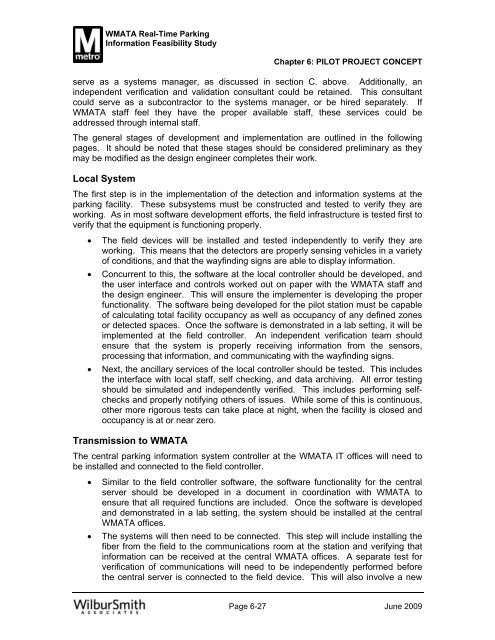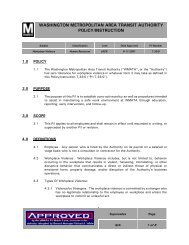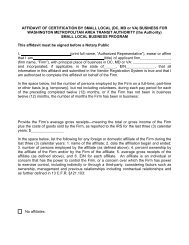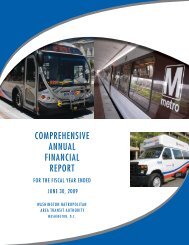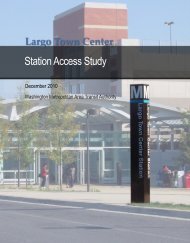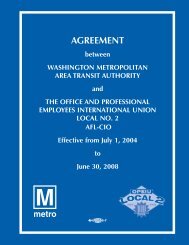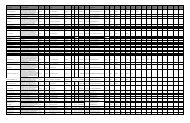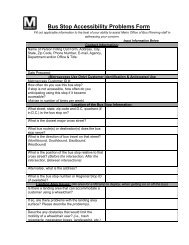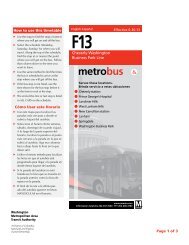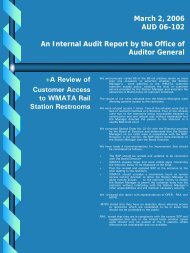feasibility study of real time parking information at ... - WMATA.com
feasibility study of real time parking information at ... - WMATA.com
feasibility study of real time parking information at ... - WMATA.com
You also want an ePaper? Increase the reach of your titles
YUMPU automatically turns print PDFs into web optimized ePapers that Google loves.
<strong>WMATA</strong> Real-Time Parking<br />
Inform<strong>at</strong>ion Feasibility Study<br />
Chapter 6: PILOT PROJECT CONCEPT<br />
serve as a systems manager, as discussed in section C. above. Additionally, an<br />
independent verific<strong>at</strong>ion and valid<strong>at</strong>ion consultant could be retained. This consultant<br />
could serve as a subcontractor to the systems manager, or be hired separ<strong>at</strong>ely. If<br />
<strong>WMATA</strong> staff feel they have the proper available staff, these services could be<br />
addressed through internal staff.<br />
The general stages <strong>of</strong> development and implement<strong>at</strong>ion are outlined in the following<br />
pages. It should be noted th<strong>at</strong> these stages should be considered preliminary as they<br />
may be modified as the design engineer <strong>com</strong>pletes their work.<br />
Local System<br />
The first step is in the implement<strong>at</strong>ion <strong>of</strong> the detection and <strong>inform<strong>at</strong>ion</strong> systems <strong>at</strong> the<br />
<strong>parking</strong> facility. These subsystems must be constructed and tested to verify they are<br />
working. As in most s<strong>of</strong>tware development efforts, the field infrastructure is tested first to<br />
verify th<strong>at</strong> the equipment is functioning properly.<br />
• The field devices will be installed and tested independently to verify they are<br />
working. This means th<strong>at</strong> the detectors are properly sensing vehicles in a variety<br />
<strong>of</strong> conditions, and th<strong>at</strong> the wayfinding signs are able to display <strong>inform<strong>at</strong>ion</strong>.<br />
• Concurrent to this, the s<strong>of</strong>tware <strong>at</strong> the local controller should be developed, and<br />
the user interface and controls worked out on paper with the <strong>WMATA</strong> staff and<br />
the design engineer. This will ensure the implementer is developing the proper<br />
functionality. The s<strong>of</strong>tware being developed for the pilot st<strong>at</strong>ion must be capable<br />
<strong>of</strong> calcul<strong>at</strong>ing total facility occupancy as well as occupancy <strong>of</strong> any defined zones<br />
or detected spaces. Once the s<strong>of</strong>tware is demonstr<strong>at</strong>ed in a lab setting, it will be<br />
implemented <strong>at</strong> the field controller. An independent verific<strong>at</strong>ion team should<br />
ensure th<strong>at</strong> the system is properly receiving <strong>inform<strong>at</strong>ion</strong> from the sensors,<br />
processing th<strong>at</strong> <strong>inform<strong>at</strong>ion</strong>, and <strong>com</strong>munic<strong>at</strong>ing with the wayfinding signs.<br />
• Next, the ancillary services <strong>of</strong> the local controller should be tested. This includes<br />
the interface with local staff, self checking, and d<strong>at</strong>a archiving. All error testing<br />
should be simul<strong>at</strong>ed and independently verified. This includes performing selfchecks<br />
and properly notifying others <strong>of</strong> issues. While some <strong>of</strong> this is continuous,<br />
other more rigorous tests can take place <strong>at</strong> night, when the facility is closed and<br />
occupancy is <strong>at</strong> or near zero.<br />
Transmission to <strong>WMATA</strong><br />
The central <strong>parking</strong> <strong>inform<strong>at</strong>ion</strong> system controller <strong>at</strong> the <strong>WMATA</strong> IT <strong>of</strong>fices will need to<br />
be installed and connected to the field controller.<br />
• Similar to the field controller s<strong>of</strong>tware, the s<strong>of</strong>tware functionality for the central<br />
server should be developed in a document in coordin<strong>at</strong>ion with <strong>WMATA</strong> to<br />
ensure th<strong>at</strong> all required functions are included. Once the s<strong>of</strong>tware is developed<br />
and demonstr<strong>at</strong>ed in a lab setting, the system should be installed <strong>at</strong> the central<br />
<strong>WMATA</strong> <strong>of</strong>fices.<br />
• The systems will then need to be connected. This step will include installing the<br />
fiber from the field to the <strong>com</strong>munic<strong>at</strong>ions room <strong>at</strong> the st<strong>at</strong>ion and verifying th<strong>at</strong><br />
<strong>inform<strong>at</strong>ion</strong> can be received <strong>at</strong> the central <strong>WMATA</strong> <strong>of</strong>fices. A separ<strong>at</strong>e test for<br />
verific<strong>at</strong>ion <strong>of</strong> <strong>com</strong>munic<strong>at</strong>ions will need to be independently performed before<br />
the central server is connected to the field device. This will also involve a new<br />
Page 6-27 June 2009


